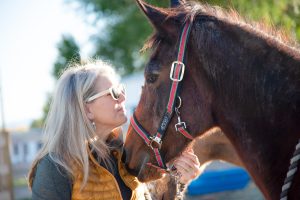Because Not Every Horse Needs A Rider
There is a hard truth in the equine industry that can be difficult for us to face: every horse will one day fall into the non-rideable, companion-only category. This fact of life leaves us with a never-ending supply of these animals. Unfortunately, the reality for most horses in America is that when they can no longer carry a rider, they are viewed as less valuable than their riding counterparts, if not altogether “useless.” Because of this industry-wide perception, most horses will pass through multiple owners in their long lifetime. And every time a horse changes hands, that horse is at risk of landing in an unsafe situation or unkind clutches. In a worst-case scenario, they may end up on a truck bound for slaughter for human use and consumption.

Companion Connection Program Manager and Lead Trainer evaluating Slew.
(break)
Spanning the past several years, we have noticed an increase in rehoming applications for equines needing retirement and/or strictly non-riding homes. Historically at Colorado Horse Rescue, unrideable horses have taken longer to find their next family than rideable horses in our adoption program. From data collected over the last three years, we’ve recorded that these horses have taken about three times as long to place than the average riding horse due to demand in our area along with specific barriers in their training and health needs.
CHR is passionate about caring for these horses who have given so much throughout their lives, which is why we decided to design and implement a new program called Companion Connection. With this focus, we now have a team dedicated to training, marketing, and efficiently placing these deserving animals into long-term homes.

Cornelius (left) and Slew (right). Two companion horses currently searching for loving homes.
(break)
Companion Connection will increase placements of our companion horses by creating individualized training and management plans for each unique horse and curating more awareness of the immense number of unrideable equines in need of homes. Additionally, as we place non-riding horses with more proficiency, CHR can take in more horses that are in need in our community and reduce the amount of time they spend on our waitlist.
We have already seen a significant improvement in the efficiency of placing non-riding equines since incorporating some of these changes into our adoption program. Companion horses currently account for half of our total departures, compared to only 20% of last year’s total placements. This massive win for our non-riding herd shows how much potential these horses have to find loving homes with the right plan.

Foster mom, Dana, and her senior companion horse, Harmony, who she is “forever fostering” through end of life.
(break)
It will always be a part of CHR’s mission to challenge our equine community to rethink our traditional perceptions of what makes up a horse’s value. We encourage owners to ask themselves these important questions: What has this horse done for me? How much of their life has been spent as my partner? What is my long-term plan for my horse when he can no longer withstand the workload he does now? As we go forward and continue to create safer pathways for all equines, we hope you all will grow alongside us and challenge your own preconceptions about these amazing animals.
To learn more about the program, head here.